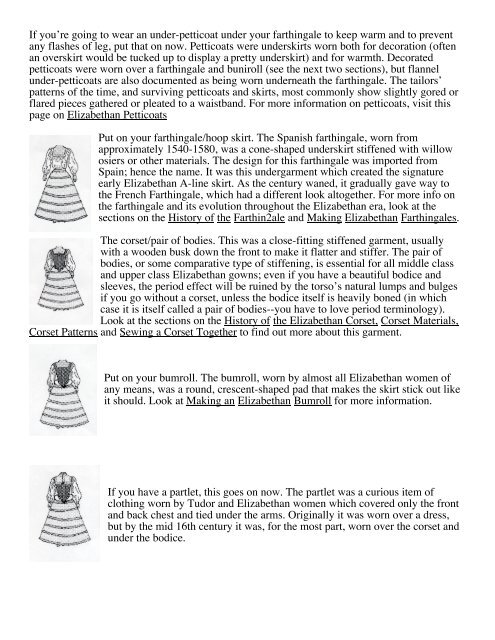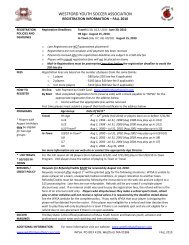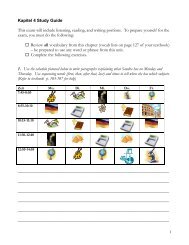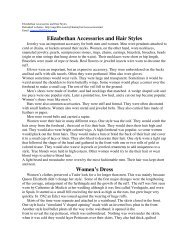Overview of an Elizabethan Outfit
Overview of an Elizabethan Outfit
Overview of an Elizabethan Outfit
Create successful ePaper yourself
Turn your PDF publications into a flip-book with our unique Google optimized e-Paper software.
If you’re going to wear <strong>an</strong> under-petticoat under your farthingale to keep warm <strong>an</strong>d to prevent<br />
<strong>an</strong>y flashes <strong>of</strong> leg, put that on now. Petticoats were underskirts worn both for decoration (<strong>of</strong>ten<br />
<strong>an</strong> overskirt would be tucked up to display a pretty underskirt) <strong>an</strong>d for warmth. Decorated<br />
petticoats were worn over a farthingale <strong>an</strong>d buniroll (see the next two sections), but fl<strong>an</strong>nel<br />
under-petticoats are also documented as being worn underneath the farthingale. The tailors’<br />
patterns <strong>of</strong> the time, <strong>an</strong>d surviving petticoats <strong>an</strong>d skirts, most commonly show slightly gored or<br />
flared pieces gathered or pleated to a waistb<strong>an</strong>d. For more information on petticoats, visit this<br />
page on Elizabeth<strong>an</strong> Petticoats<br />
Put on your farthingale/hoop skirt. The Sp<strong>an</strong>ish farthingale, worn from<br />
approximately 1540-1580, was a cone-shaped underskirt stiffened with willow<br />
osiers or other materials. The design for this farthingale was imported from<br />
Spain; hence the name. It was this undergarment which created the signature<br />
early Elizabeth<strong>an</strong> A-line skirt. As the century w<strong>an</strong>ed, it gradually gave way to<br />
the French Farthingale, which had a different look altogether. For more info on<br />
the farthingale <strong>an</strong>d its evolution throughout the Elizabeth<strong>an</strong> era, look at the<br />
sections on the History <strong>of</strong> the Farthin2ale <strong>an</strong>d Making Elizabeth<strong>an</strong> Farthingales.<br />
The corset/pair <strong>of</strong> bodies. This was a close-fitting stiffened garment, usually<br />
with a wooden busk down the front to make it flatter <strong>an</strong>d stiffer. The pair <strong>of</strong><br />
bodies, or some comparative type <strong>of</strong> stiffening, is essential for all middle class<br />
<strong>an</strong>d upper class Elizabeth<strong>an</strong> gowns; even if you have a beautiful bodice <strong>an</strong>d<br />
sleeves, the period effect will be ruined by the torso’s natural lumps <strong>an</strong>d bulges<br />
if you go without a corset, unless the bodice itself is heavily boned (in which<br />
case it is itself called a pair <strong>of</strong> bodies--you have to love period terminology).<br />
Look at the sections on the History <strong>of</strong> the Elizabeth<strong>an</strong> Corset, Corset Materials,<br />
Corset Patterns <strong>an</strong>d Sewing a Corset Together to find out more about this garment.<br />
Put on your bumroll. The bumroll, worn by almost all Elizabeth<strong>an</strong> women <strong>of</strong><br />
<strong>an</strong>y me<strong>an</strong>s, was a round, crescent-shaped pad that makes the skirt stick out like<br />
it should. Look at Making <strong>an</strong> Elizabeth<strong>an</strong> Bumroll for more information.<br />
If you have a partlet, this goes on now. The partlet was a curious item <strong>of</strong><br />
clothing worn by Tudor <strong>an</strong>d Elizabeth<strong>an</strong> women which covered only the front<br />
<strong>an</strong>d back chest <strong>an</strong>d tied under the arms. Originally it was worn over a dress,<br />
but by the mid 16th century it was, for the most part, worn over the corset <strong>an</strong>d<br />
under the bodice.






